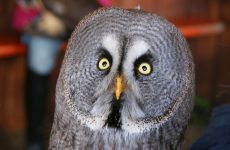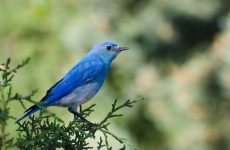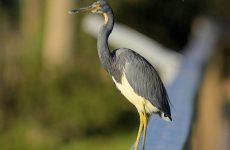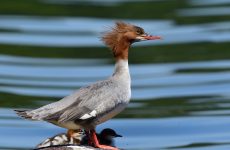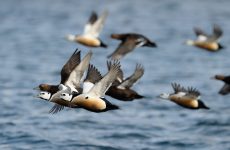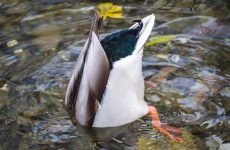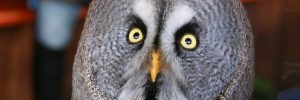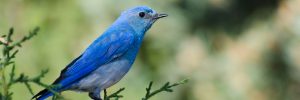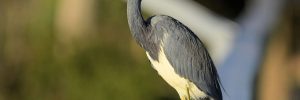There are a surprising number of ducks that are black and white in North America, and this guide will help you identify them.
Ducks can be difficult to identify as they are often further away and obscured by water. Sometimes it is the female that is black and white, and also the male when they are in non-breeding plumage.
So check out these black and white ducks or ducks that look black and white from a distance and see if you can find the one your looking for with the help of photos, calls, and region information.
You can also find out more about ducks and their calls or check out which ducks are in your state or province from the main menu.
1. Bufflehead
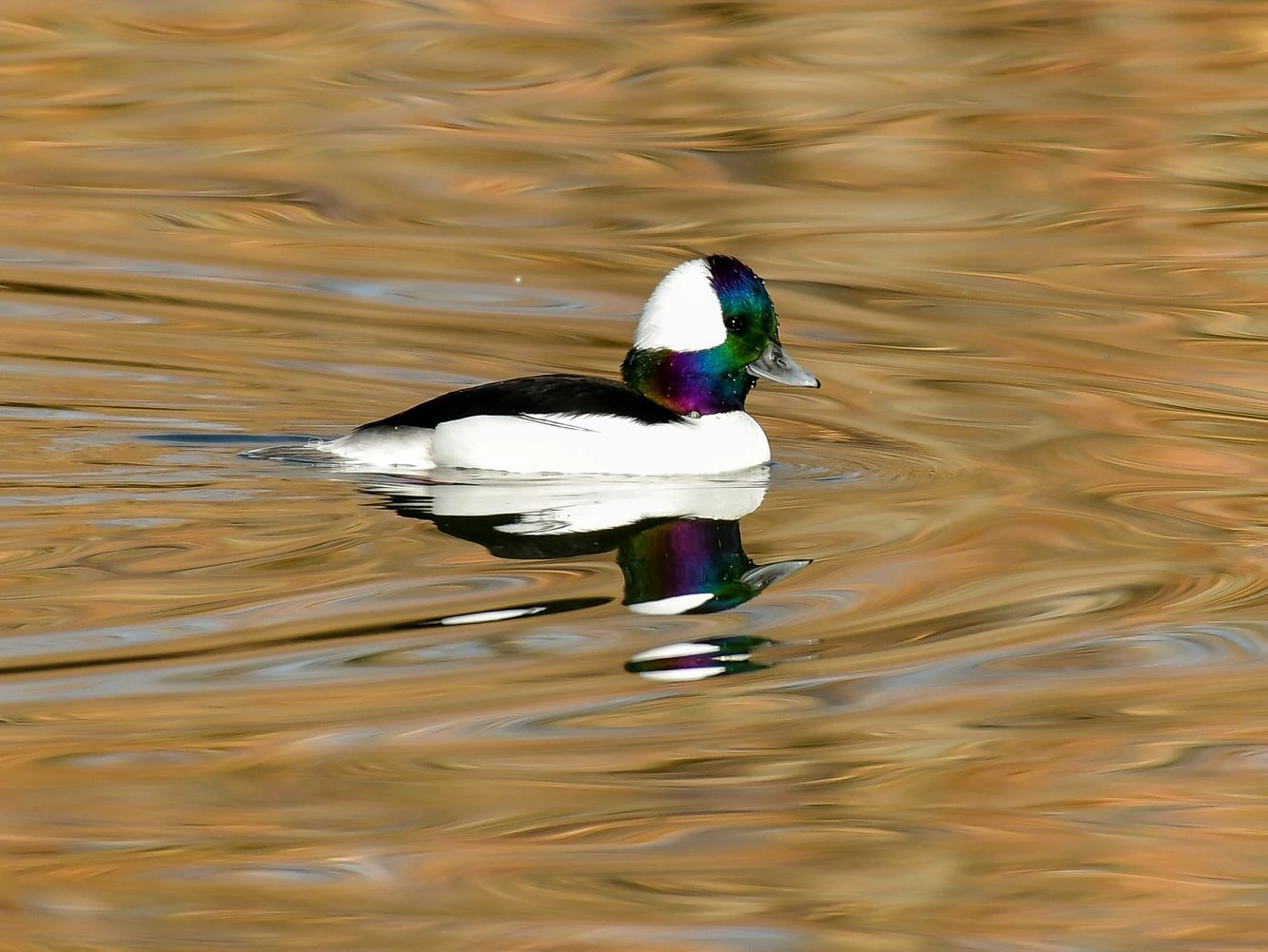
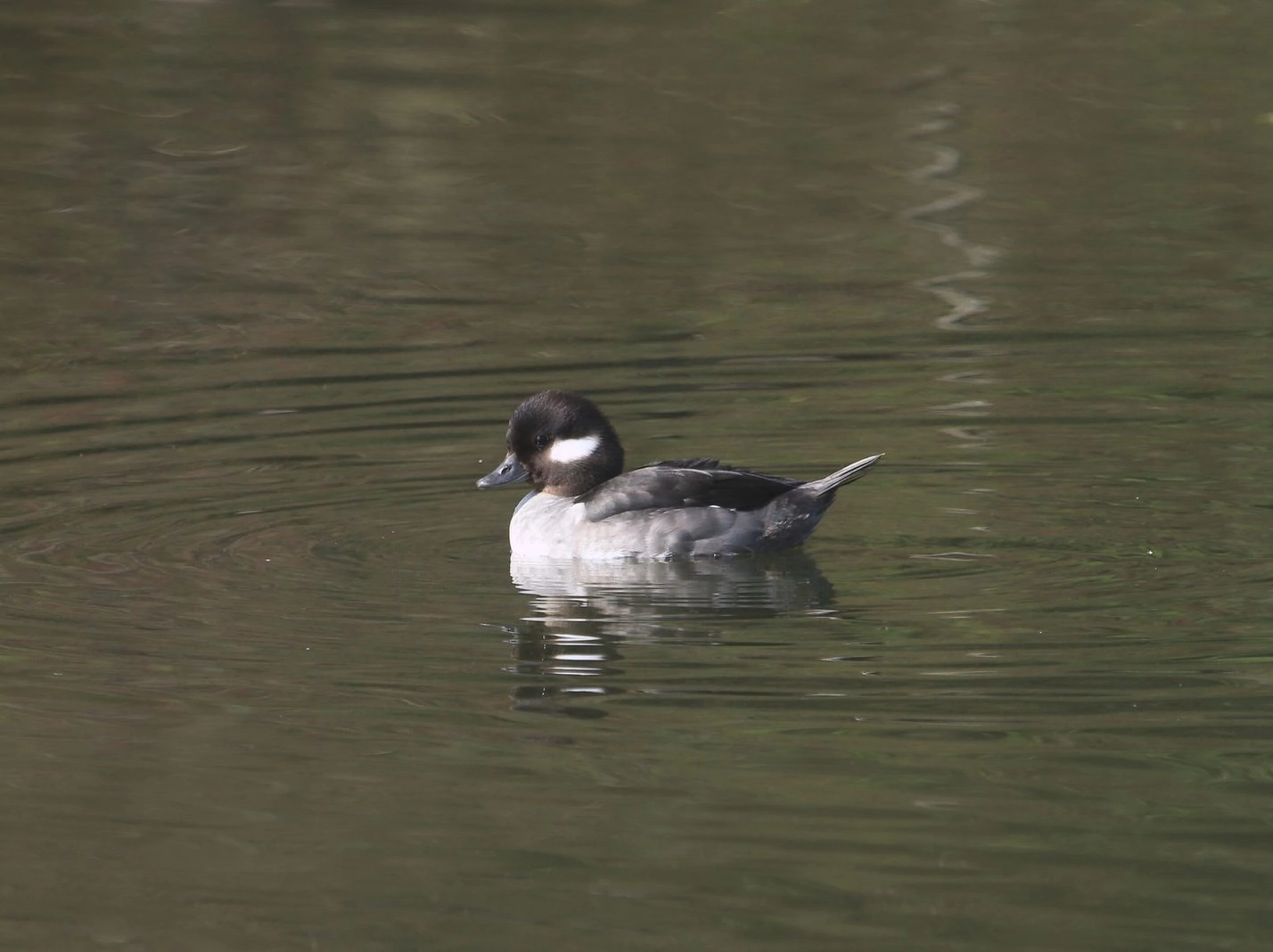
Buffleheads are small birds with bulbous heads, hence their name, “bullheaded,” from ancient Greek. Male Buffleheads are easily recognizable because of the huge white patch behind their eyes. This patch highlights the glossy green and purple colors on the crown, forehead, throat, and neck. The bottom half of their bodies are white, while the upper half is black.
Female Buffleheads look nothing like the males, except for the bulbous head. They have dark brown or black heads with a white patch below the eye. Their bottom half is gray, and their top half is black. Juveniles look similar to females with their brown heads and a white patch on the head.
- Bucephala albeola
- Length: 13 – 16 in (33 – 41 cm)
- Weight: 21.16 oz (600 g)
- Wingspan: 20 – 24 in (51-61 cm)
Buffleheads breed mainly in Canada before migrating to the US, northern Mexico, and Canada’s Pacific coast. They can be seen during migration in the Midwest and the Appellations.
You can find Buffleheads in small lakes and ponds with nearby poplar and aspen forests during the breeding season. In the winter, they move to protected coastal waters or shallow bays and inlets.
Buffleheads mostly dive as they forage for food. They catch mollusks, crustaceans, and aquatic insects, which they eat while underwater.
Bufflehead Calls: Buffleheads are quiet birds and don’t make particularly loud calls. Males usually only make sounds around the breeding season and make chattering sounds or squeals. Females call to their young.
Male Bufflehead call
Female Bufflehead call
Nests of Buffleheads are often found in tree cavities, particularly those previously used by Northern Flicker woodpeckers. These are very small tree holes that are close to water. The female places several down feathers on the nest just enough to cover the eggs. She lays from six to eleven eggs that she incubates for thirty days.
Attract Buffleheads to your backyard by putting up nest boxes. There is a lot of nest competition with other goldeneyes, which drives Buffleheads to seek safer and better nesting areas.
Fun Fact: Buffleheads are monogamous ducks and may remain with their chosen mate for several years.
2. Ring-necked Duck
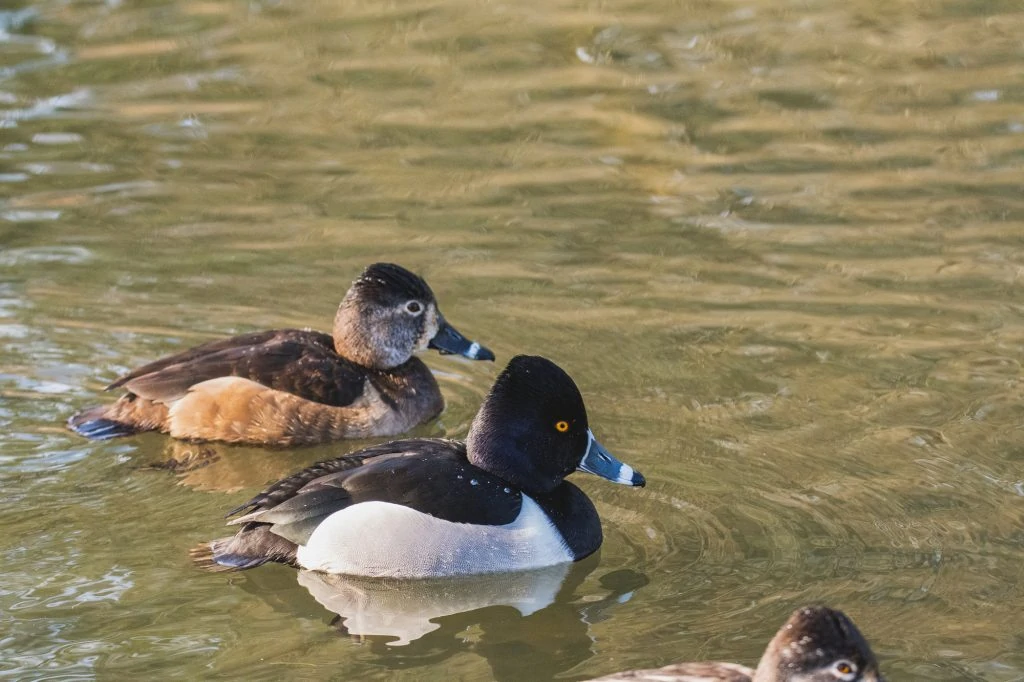
Ring-necked Ducks are medium-sized ducks that have a steep black forehead, a gray bill fringed with white and a black tip, a black chest and back, and a white breast and belly. They have a cinnamon collar around their neck.
Females don’t show the ring and are mostly brown everywhere except for their gray faces and white outline around their eyes. Their bills also don’t have the white outline the males have, but they do have a white band near the black tip of their bill.
- Aythya collaris
- Length: 14 – 18 in (36 – 46 cm)
- Weight : 32.09 oz (909 g)
- Wingspan: 24 – 30 in (61 – 76 cm)
Ring-necked Ducks breed in Canada and northeastern US states before migrating to southern and western US states, Mexico, northern Central America, and the Caribbean.
You can find Ring-necked Ducks in small, shallow ponds and rivers. Breeding habitats may include wooded lakes in forests.
You can find Ring-necked Ducks foraging on the surface and only occasionally diving below the water in small, shallow ponds and rivers. Even though they are diving ducks, they behave more like dabbling ducks.
They eat plants on the surface of the water and submerged plants like pondweed. They also eat wild rice and animals such as earthworms, leeches, and snails.
Ring-necked Duck Calls: A series of barking grunts
Nests of Ring-necked Ducks are bowl-shaped and built on shallow water with a lot of vegetation for cover. They are made with plant materials and can hold as many as ten eggs. The females incubate these eggs for about a month and stay with the young until they’re ready to fly.
Fun Fact: Though you may think that the ring around the Ring-necked Duck is used to easily distinguish them from other birds, you’d be mistaken. It’s hardly noticeable. Better to look for their steep, black forehead and blue-gray bill with the white band.
3. Hooded Merganser
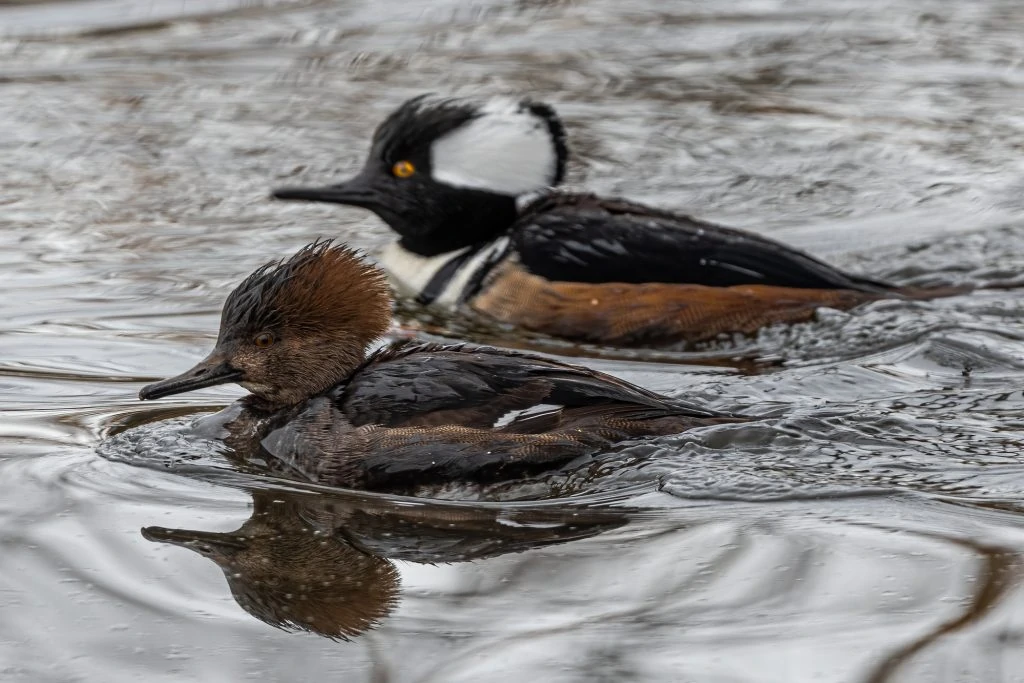
The Hooded Merganser is the second smallest species of Merganser and the only Merganser that lives entirely in North America.
Male Hooded Mergansers are striking ducks because of the crests on their head that they can raise or lower, which then changes the shape of their head and the pattern of the crest. When open, the crests are huge white patches, but when closed, they are a thick white line.
Apart from the white crests, their heads are black, and they have golden yellow eyes. Their bodies are black, except for their cinnamon-colored flanks and white chests. They have two black bars on their chests, and their lower backs have white stripes.
Females have the same crest, but theirs is reddish-brown. Their bodies are brownish-gray all over, lighter on the bottom and darker on top. Their eyes are somewhat duller than the males. Juveniles have brownish crests, black top half, and brownish-gray on their bottom half.
- Lophodytes cucullatus
- Length: 16 – 19 in (41 – 48 cm)
- Weight: 32.09 oz (909 g)
- Wingspan: 24 – 26 in (61 – 66 cm)
Hooded Mergansers live in eastern US states all year, but those in eastern Canada migrate for winter. They also spend all year in southwestern Canada. They can be spotted during migration in the Midwest and in winter in southern US states and the West Coast.
You can find Hooded Mergansers in freshwater lakes, ponds, and slow-moving rivers. They prefer to breed in small, forested ponds and estuaries with lots of aquatic vegetation. During migration, they visit a wide range of habitats, like open water, coastal bays, and tidal creeks. In winter, they are found in brackish swamps, saltwater bays, and inlets.
Hooded Mergansers forage by diving underwater. They catch their prey with their serrated and hooked bill. They will eat aquatic insects, fish, and crustaceans, particularly crayfish. In forested regions, they may eat snails, frogs, aquatic plants, and seeds.
Hooded Merganser Call: They are usually silent, but male Hooded Mergansers will make a frog-like croak during courtship, and females make a flight call.
Male Hooded Merganser call
Female Hooded Merganser call
Nests of Hooded Mergansers are often found in tree cavities that are about ten to twenty feet above the ground. They are usually beside or close to a water source and lined only with down feathers. Females lay seven to fifteen eggs and will incubate them all at the same time after the last egg has been laid. The incubation period usually takes just over thirty days.
Within twenty-four hours after hatching, the young jump to the ground from the nest and head to the closest water source. They can swim on their own and are able to find their own food. The female will still tend to them and lead them to areas with abundant food but only for a few more weeks.
Fun Fact: Hooded Mergansers are able to see underwater, which helps them when they forage for food.
4. Common Merganser
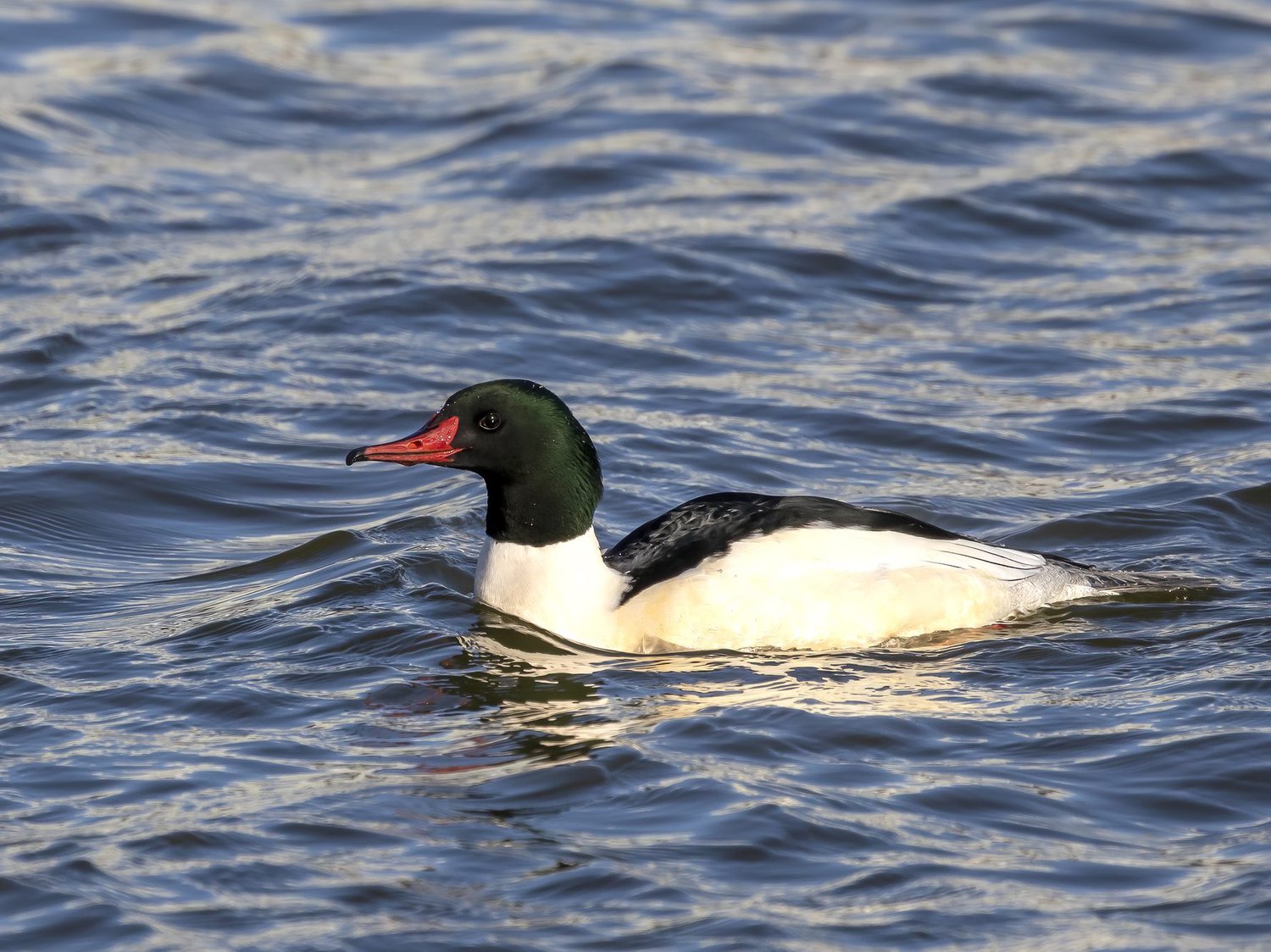
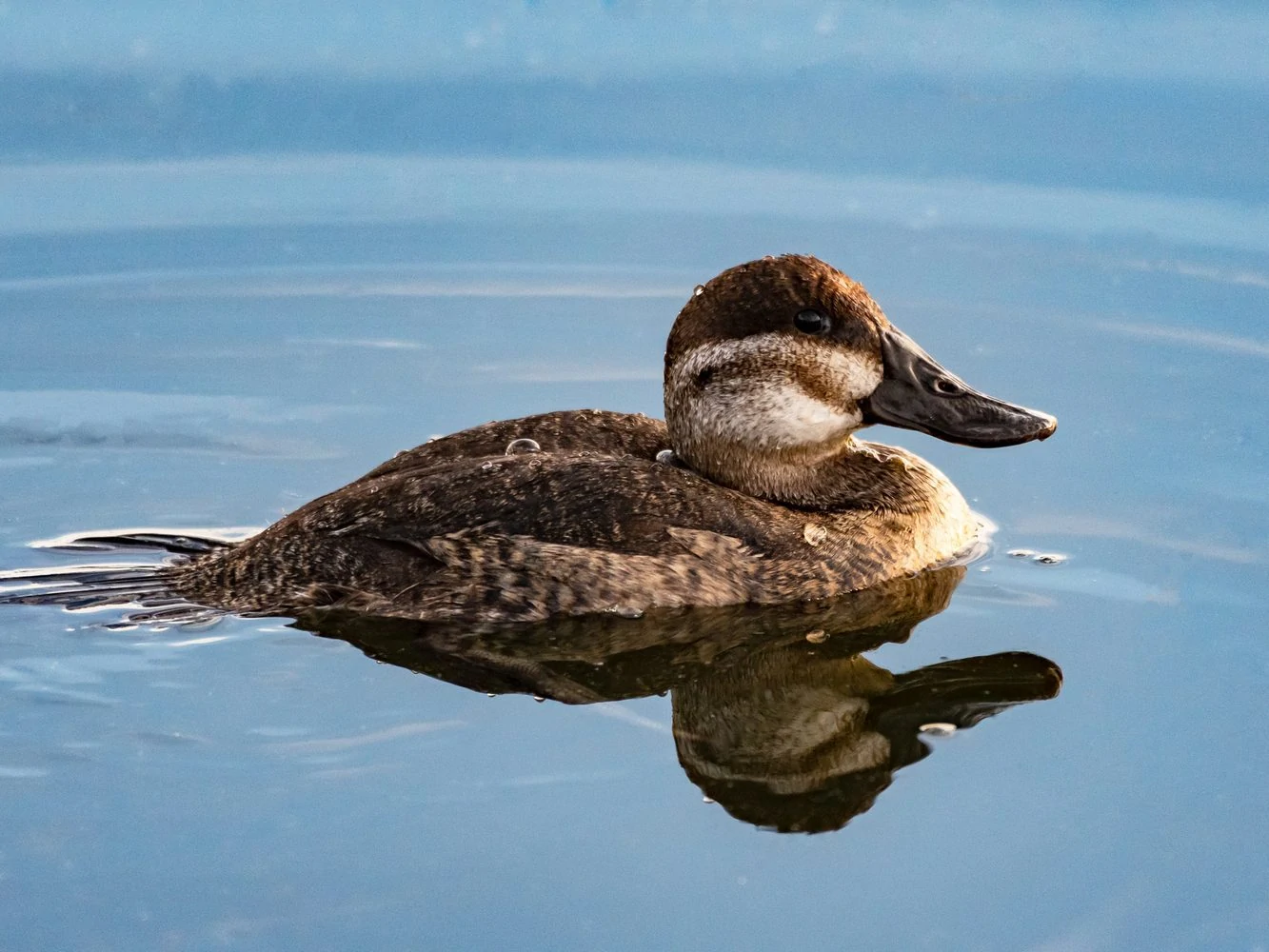
Male Common Mergansers are simple-patterned birds but striking nonetheless. They have black heads with a glossy green sheen, dark eyes, bright-red, long, serrated bills, white bodies, and black backs. While they do have a crest, it’s not often visible.
Females have a more prominent reddish-brown crest. They have the same red, serrated bill as the males. They also have a white chin patch, and their breast and bellies are white, their backs are gray. Juveniles resemble females.
- Mergus merganser
- Length: 22 – 27 in (56 – 69 cm)
- Weight: 60.8 oz (1723 g)
- Wingspan: 31 – 37 in (79 – 94 cm)
Common Mergansers breed in Canada and migrate to the US. Some remain all year in northeastern and northwestern US states.
You can find Common Mergansers in freshwater lakes and ponds. They are also found in small rivers and shallow shorelines and even sitting on rocks in the middle of a stream. While they prefer freshwater habitats, they sometimes visit saltwater regions too, like coastal estuaries and harbors.
Common Mergansers are diving ducks, and they love to eat fish, particularly the adults. Their serrated bills make it easy for them to capture and hold these fish as well as mussels, crustaceans, and other aquatic creatures. Gulls often follow them when hunting to steal the fish from them.
Common Merganser Calls: They are usually fairly quiet, but Male Common Mergansers give alarm calls, and females make a series of grunting calls to their young.
Male Common Merganser call
Female Common Merganser call
Nests of Common Mergansers are usually found in a tree cavity in mature forests. They often use abandoned tree holes and line them with down feathers. They also use nest boxes where available. If there are no tree cavities, they use crevices on cliffsides.
Females lay six to seventeen eggs and have been known to lay eggs in other nests of the same species. They incubate these eggs for around thirty days. When the young hatch, they immediately head for the water to feed themselves. The female may assist them in finding food, but otherwise, they fend for themselves.
Fun Fact: Common Mergansers are also called “sawbills,” “fish ducks,” or “goosanders.”
5. Common Goldeneye
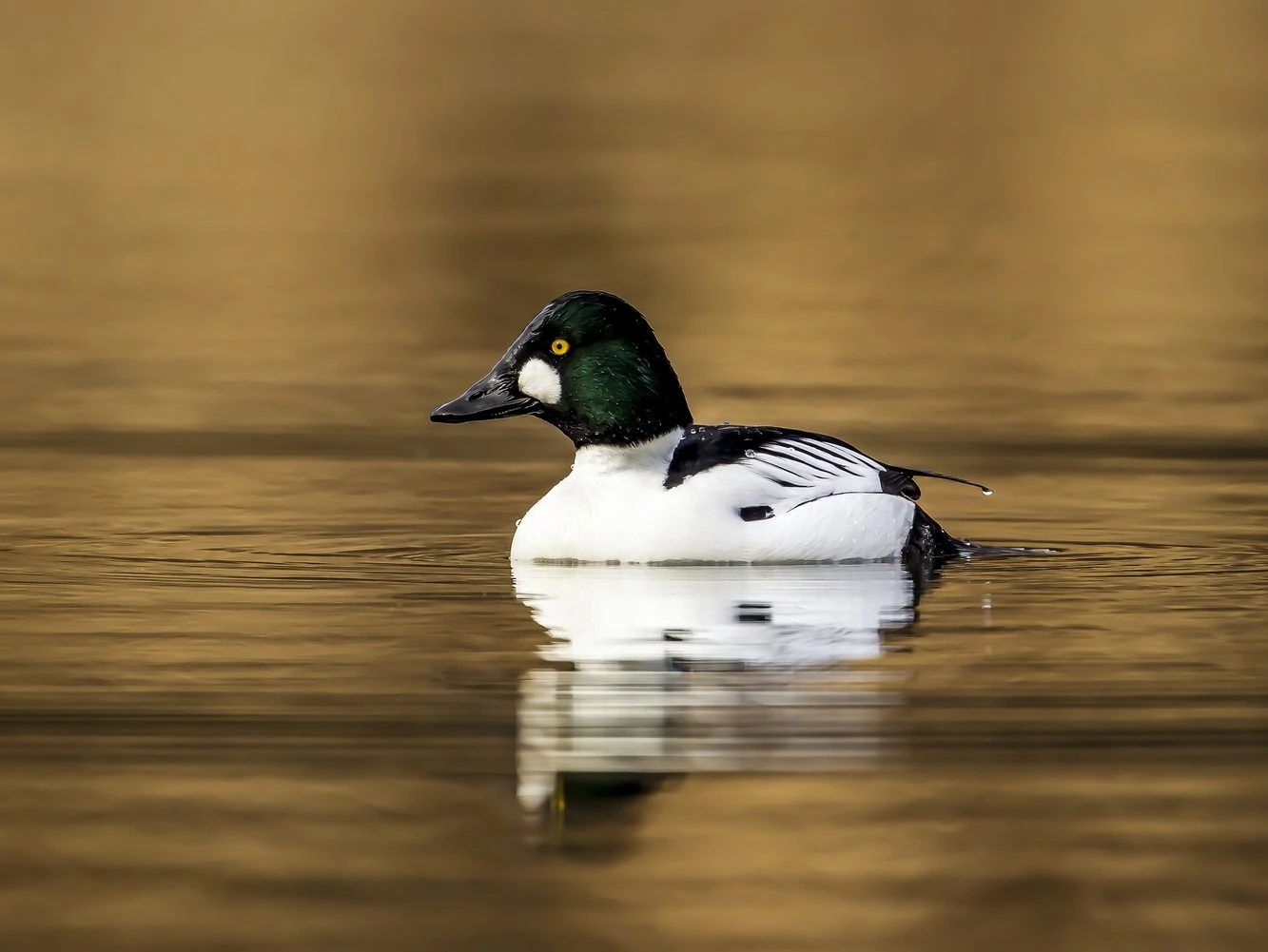
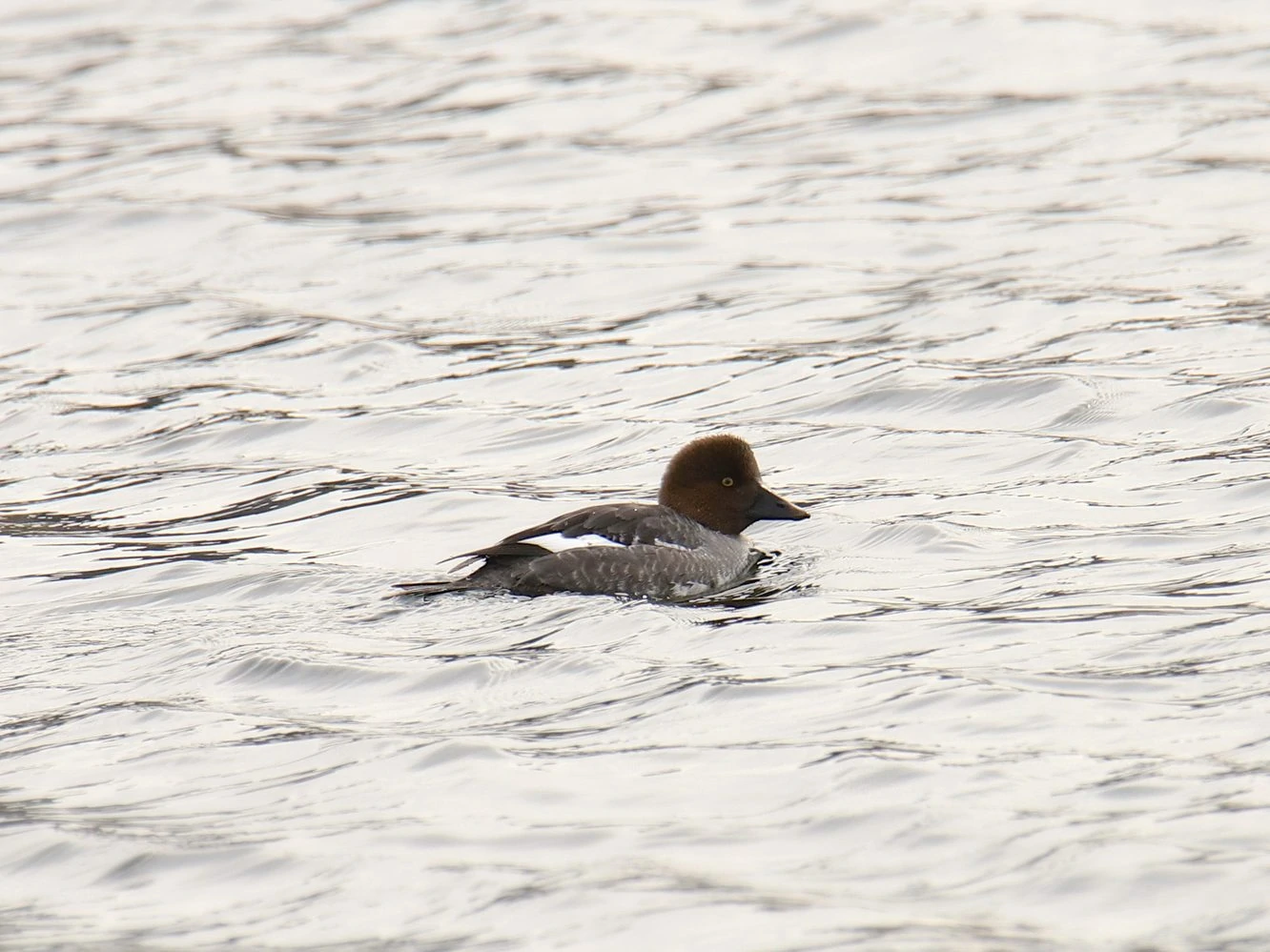
Common Goldeneye males have green heads that are iridescent and can look almost black. They have a white spot under their yellow eyes. They have white bodies and sides and black backs.
Female Common Goldeneyes are grayish-brown with brown heads. Both males and females have black bills, but females have a yellow tip.
- Bucephala clangula
- Length: 15.8 – 20.1 in (40 – 51 cm)
- Weight: 21.2 – 45.9 oz (600 – 1300 g)
- Wingspan: 30.3 – 32.7 in (77 – 83 cm)
Common Goldeneyes breed in Canada and Alaska in summer and migrate late to the lower 48 for winter.
You can find Common Goldeneyes in boreal forest lakes during the breeding season and in coastal areas in winter. Common Goldeneyes are diving ducks that feed on crabs, shrimp, crayfish, fish, fish eggs, and insects.
Common Goldeneye Calls: They are quiet ducks, but male Common Goldeneyes make soft calls, and females make harsh alarm calls.
Common Goldeneye Male
Common Goldeneye Alarm call
Nests of Common Goldeneye are in holes in trees, and they use whatever is in there, plus some plucked-down feathers for the nesting material. They lay up to nine eggs which take around thirty days to hatch.
Fun Fact: Common Goldeneyes can fly at speeds of over 40 miles per hour.
6. Lesser Scaup
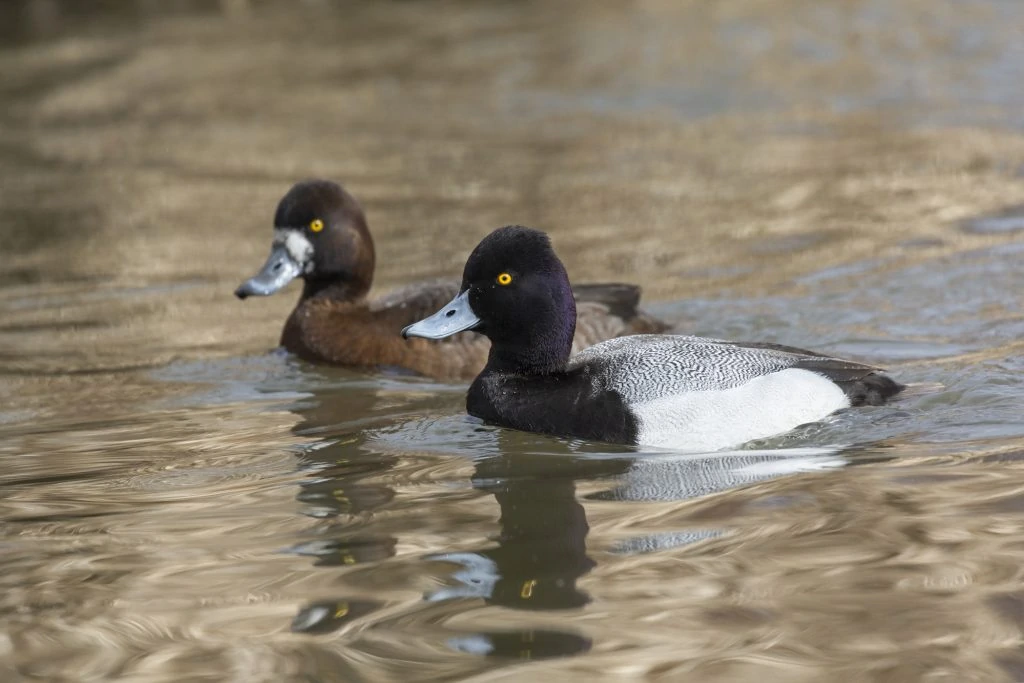
Lesser Scaups are medium-sized diving birds that are pretty similar and often mistaken for Greater Scaups. What makes them different is that Lesser Scaups have a small group of hairs at the tip of their heads. It makes their head look steeper than Greater Scaups.
Their heads, chests, and bottoms are all black with a purple sheen. Their eyes are golden yellow. Their sides are white, and their backs are grayish with an intricate pattern.
Females have dark-brown heads, a white patch on their face next to their bills, gray sides, and are brown all over, and no extra tuft of hair on the head like the males.
- Aythya affinis
- Length: 15 – 18 in (38 – 49 cm)
- Weight: 40.77 oz (1155 g)
- Wingspan: 24 – 33 in (61 – 84 cm)
Lesser Scaups breed in northwestern US states, western Canada, and Alaska before migrating to southern US states, Mexico, and the east and west US coasts. They can be seen during migration across the rest of the US and Canada.
You can find Lesser Scaups in large lakes, rivers, ponds, and reservoirs. They usually flock together by the thousands during winter, and they often look like floating vegetation when viewed from afar.
Lesser Scaups feed primarily on mollusks and clams that they find after diving into the water and sifting through the bottom. They also dabble in the water for plant vegetation like bulrushes, wild celery, wild rice, and pondweeds.
Recently, they have begun to feed on zebra mussels in Lake Erie, which may endanger their health because these animals are filter feeders and contain environmental contaminants.
Lesser Scaup calls: Male Lesser Scaups are quiet and only make soft gurgle calls. However, females are much louder and make harsh grunts.
Male Lesser Scaup
Female Lesser Scaup
Nests of Lesser Scaups are usually found on the ground very close to the water. Females may share their nests with others, so one nest may contain eggs from more than one female. The nests themselves are scraped and lined with plants and feathers.
One female may lay up to eleven eggs, but the nest may contain up to twenty-six eggs, including those from other females. Incubation lasts only three weeks, and the young immediately head to the water after hatching.
The young are cared for by the females, but they can feed themselves. In about fifty days, they are able to fly and migrate with the others.
Fun Fact: An adult Lesser Scaup may pretend to be dead when in the jaws of a predator like the Red Fox.
7. Red-breasted Merganser
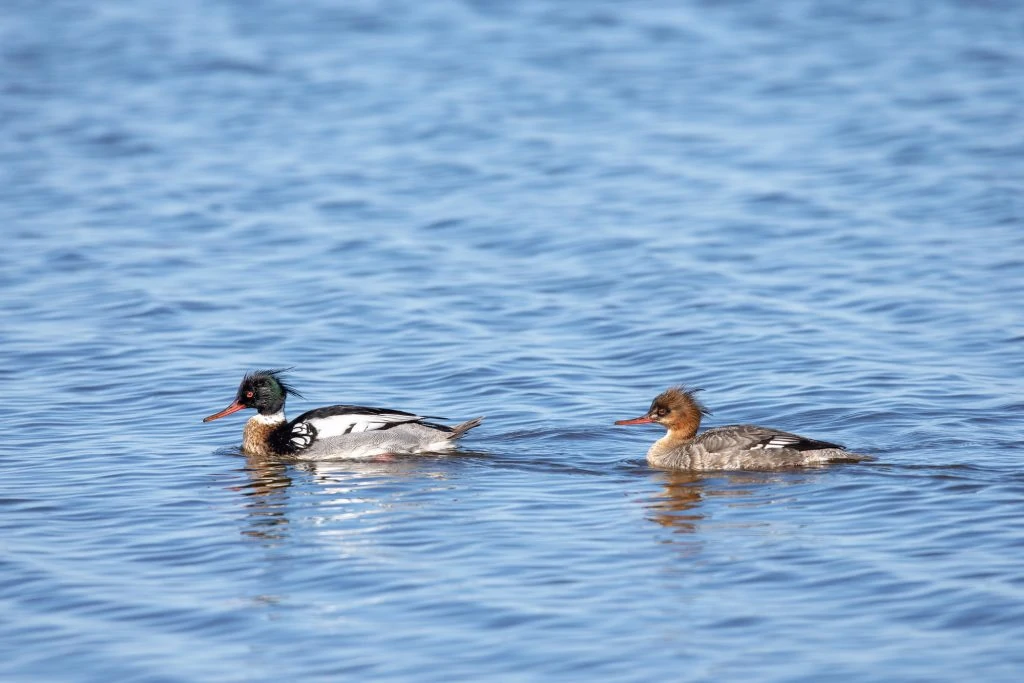
Breeding Male Red-breasted Mergansers are certainly noticeable ducks. Their black, glossy green, ragged, and spiky crests, dark red eyes, and long, serrated orange bills certainly make them stand out among other ducks. They also have a white neck collar, mottled reddish-brown breast, black and white back, and gray flanks.
Females and non-breeding males have reddish-brown spiky crests, red eyes, long, red bills, white throats, and gray bodies.
- Mergus serrator
- Length: 16 – 26 in (41 – 66 cm)
- Weight: 47.61 oz (1349 g)
- Wingspan: 31 – 35 in (79 – 89 cm)
Red-breasted Mergansers breed in Canada, except in the southwest, before migrating to the coasts of the US and Canada. They can be spotted during migration in southwestern Canada and all US states.
You can find Red-breasted Mergansers in tundra ponds, freshwater lakes and rivers, and brackish and saltwater wetlands, usually near the coast during the breeding season. In winter, they may also be found in the ocean.
Red-breasted mergansers normally dive when foraging for food and will pursue their prey underwater until they catch them. They will occasionally cooperate with other groups and herd schools of fish into shallow waters to make them easier to catch. Aside from fish, they also eat crustaceans, insects, and amphibians.
Red-breasted Merganser call: They are quiet birds, but they make calls during courtship or when alarmed.
Male Red-breasted Merganser
Female Red-breasted Merganser
Nests of Red-breasted Mergansers are often found on the ground, in a shallow depression, near the water. Females usually line them with plants and down feathers. Females lay five to sixteen eggs but may lay them in other females’ nests. The incubation period may run from twenty-nine to thirty-five days and is mostly done by the female.
Fun Fact: Red-breasted Mergansers don’t acquire their breeding feathers until they are two years old.
8. Greater Scaup
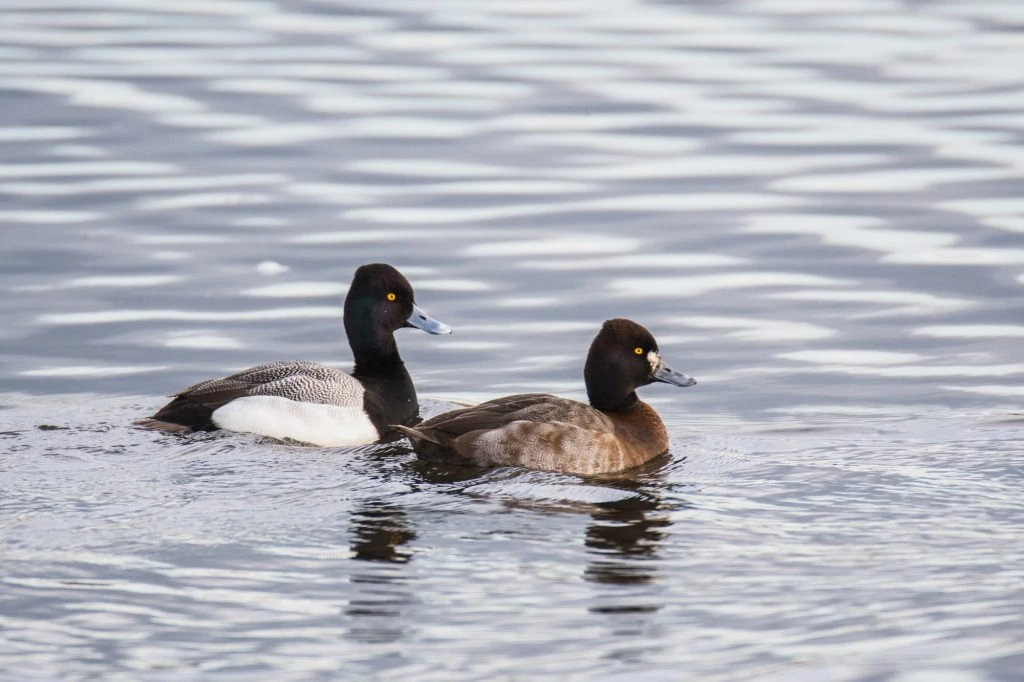
Greater Scaup males are ducks with iridescent dark green heads with blue bills, gray barred backs, and white sides. From a distance, they look black and white. Males molt after the breeding season and have mottled brown and gray bodies with darker heads.
Females are brown with a white patch between each eye and bill. Both males and females have yellow eyes. Greater Scaups look very similar to Lesser Scaup except with rounder heads.
- Aythya marila
- Length: 15.3 – 22.1 in (39 – 56 cm)
- Weight: 25.6 – 48.0 oz (726 – 1360 g)
- Wingspan: 28.4 – 31.1 in (72 – 79 cm)
Greater Scaups breed in the north of Canada and in Alaska before migrating to the Pacific and Atlantic Coasts for winter, but more on the Atlantic side.
You can find Greater Scaups in shallow lakes and ponds during the breeding season. In winter, they migrate towards the coast and can be found in bays and shores, but also on the Great Lakes. They form huge ‘rafts’ of birds out at sea.
Greater Scaups are diving ducks that eat invertebrates and plants at the bottom of lakes and the sea. They will push their open bills into the soft mud while swimming forward and quickly close it on any prey.
Greater Scaup call:
Greater Scaup flight call
Nests of Greater Scaup are on the ground, near water, and they add grass and down feathers to the small depression. They sometimes lay their eggs on floating mats of vegetation. They lay up to thirteen eggs which take around twenty-five days to hatch. The young leave the nest almost immediately.
Fun Fact: Greater Scaups can dive up to 23 feet underwater to hunt on the bottom for food.
9. Long-tailed Duck
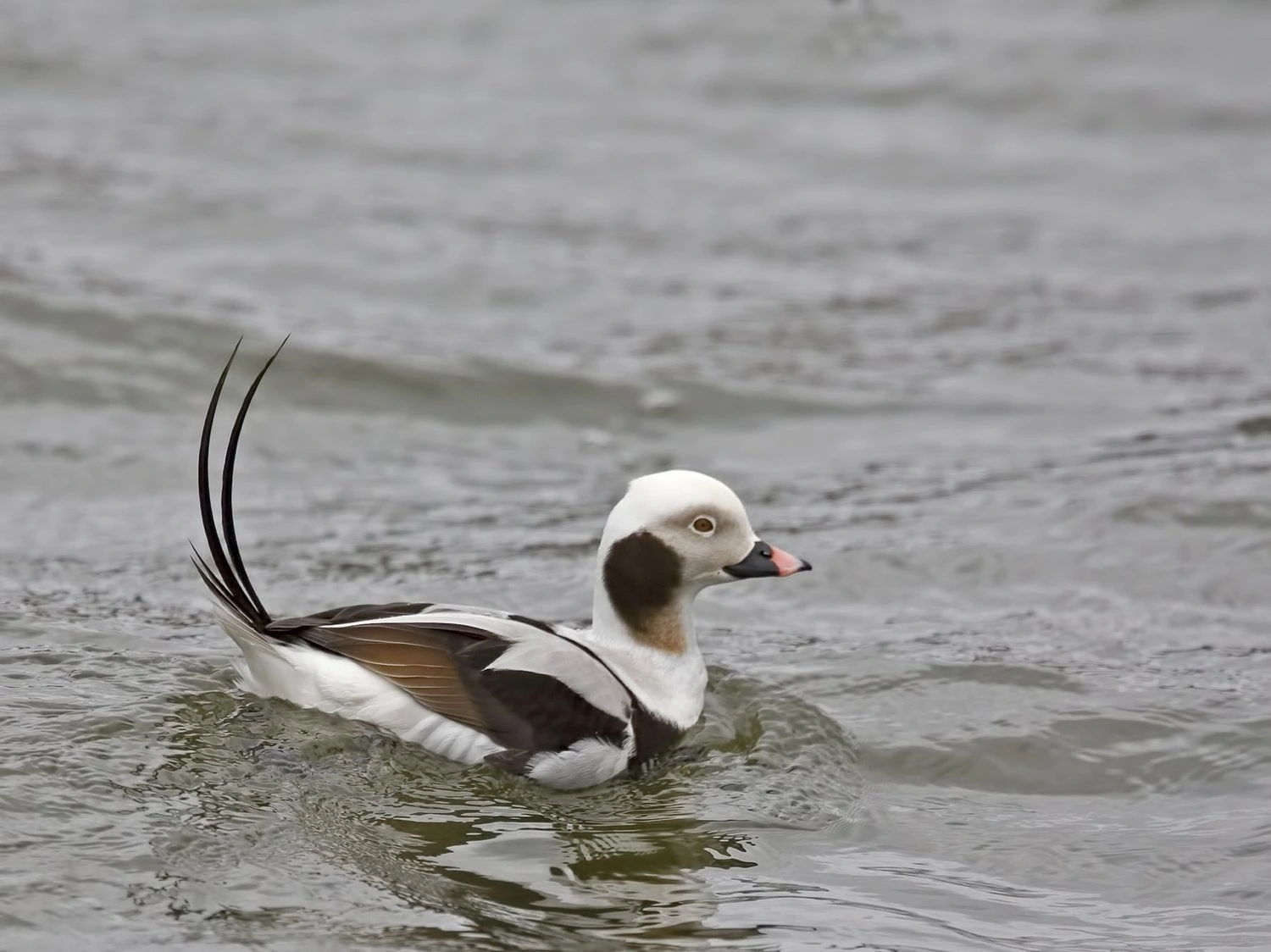
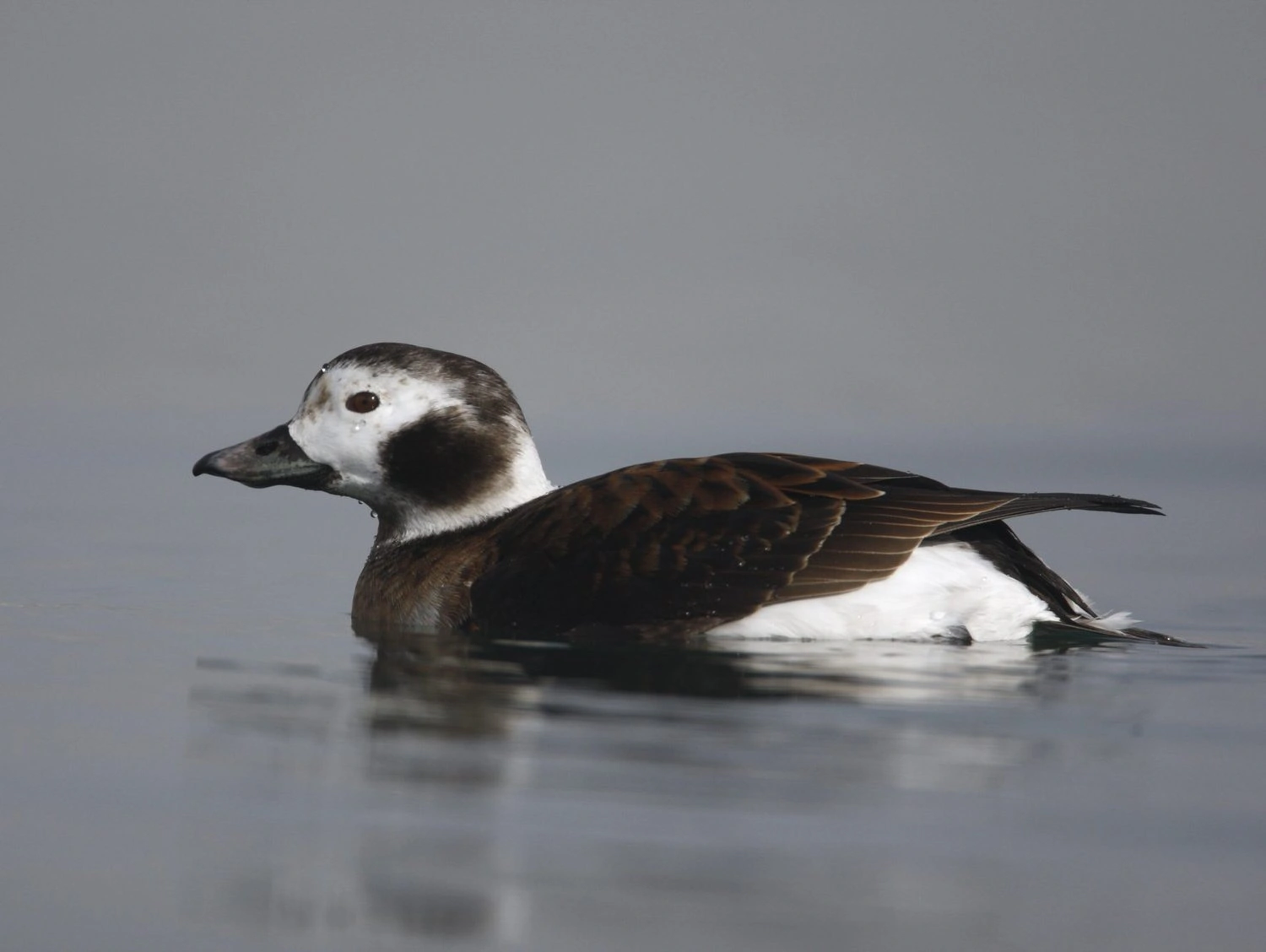
The Long-tailed Duck is a small diving duck that has rather obvious slender, long and black tail feathers, hence the name. What’s interesting about the Long-Tailed Duck is that its coloring reverses between breeding (summer) and non-breeding (winter) seasons.
Adult non-breeding males have white crowns, foreheads, necks, backs, sides, and bellies. They have a gray mask and a dark cheek patch, a pink band across their black bill, and black breasts and wings with white shoulder blades. Their tails are long and black.
Their coloring reverses during the breeding season or in summer. Everything that was white is now dark-colored. Their crown, foreheads, necks, backs, sides, and bellies are now dark. Their cheek patch is now white, and the band on their dark bill is now gray.
Adult non-breeding females have dark crowns, white heads with a dark patch on the cheek, and gray bills. They have white necks and bellies. They have brown throats, backs, wings, and a relatively shorter tail. Like the males, their coloring reverses during the breeding season. They become browner overall but with a white patch around the eye and neck.
Juveniles resemble adult non-breeding females, particularly in coloring and with a shorter tail. But they have a darker patch on the cheek and a yellow-orange band on the gray bill like the adult males.
- Clangula hyemalis
- Length: 15 – 22 in (38 – 56 cm)
- Weight: 31.74 oz (900 g)
- Wingspan: 26 – 31 in (66 – 79 cm)
Long-tailed Ducks breed in the far north of Canada and Alaska and across northern Europe and northern Asia. In winter, they migrate south to the US, and those in Europe and Asia move south in these regions.
You can find Long-Tailed Ducks in many coastal water habitats. They are often in bays, harbors, fjords, estuaries, straits, and mudflats. During the breeding season, you can find them along ocean coasts and large freshwater lakes. They are known to join large flocks in areas with extensive sea ice.
Long-tailed Ducks usually dive for mollusks, crustaceans, and small fish in the oceans during winter. They are known to dive as deep as 200 feet to reach zooplankton that is usually at the bottom of water columns. They use their wings to propel them through the water. On the tundra, during summer, they mostly eat insects, fish eggs, and plants.
Long-tailed Duck calls:
Male Long-tailed Duck
Female Long-tailed Duck
Nests of Long-tailed Ducks are usually shallow depressions on the ground made by females. They are grouped together in small, tight clusters with other females’ nests. The first egg is covered with a layer of grasses, and with the addition of a second egg, the females add their own down to the nest.
Females can lay anywhere from six to nine eggs. They alone incubate the eggs for up to twenty-nine days. Males leave for their post-breeding molting site. The young are able to feed when they hatch.
Fun Fact: The Long-tailed Duck used to be known as “oldsquaw.”
10. Common Eider
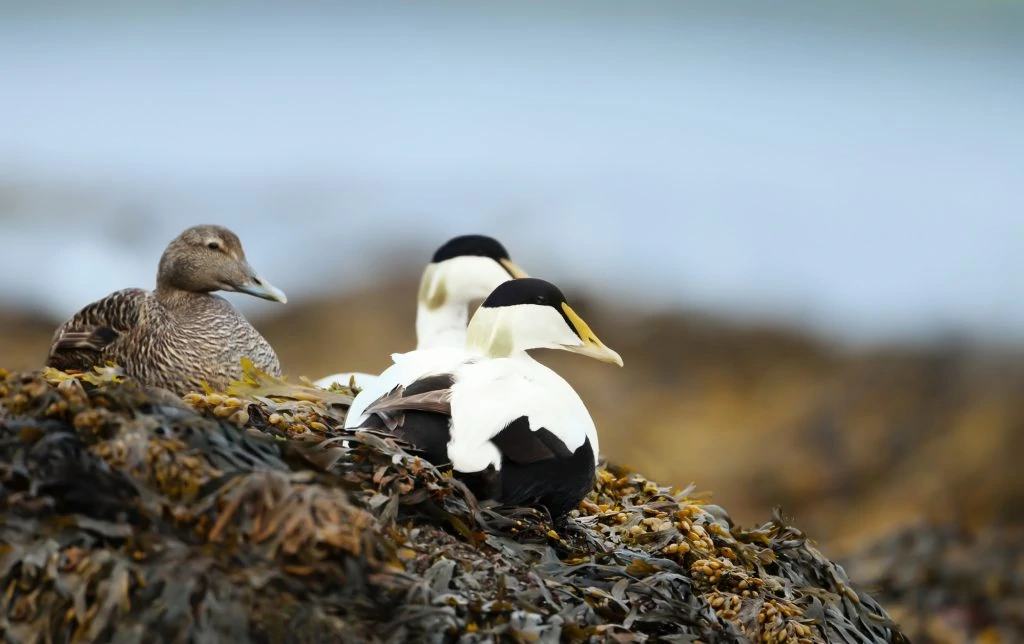
Common Eiders are large sea ducks with sloping foreheads. Breeding males generally have white cheeks and backs, black caps, sides, and bellies, and pistachio-colored napes (back of the neck).
Females are reddish-brown all-over with black barring on their breasts, backs, and wings. Juveniles and non-breeding males are chocolate brown with varying degrees of white coloring on their breasts and backs.
- Somateria mollisima
- Length: 23 – 27 in (58 – 69 cm)
- Weight: 78.4 oz (2222 g)
- Wingspan: 35 – 42 in (89 – 107 cm)
Common Eiders have six subspecies, four of which breed in North America and have slight differences between them.
Common Eiders breed in Canada and Alaska and parts of northern Europe and Asia. Some remain in those areas in winter all year, but others migrate south.
You can find Common Eiders in marine or saltwater habitats that are near rocky coastlines. During the breeding season, you can find them in large colonies on coastal islands, islets, and shorelines with vegetation, shrubs, and stunted trees.
In winter, they settle in locations with rocky seafloors to easily forage for mollusks.
Common Eiders mainly eat mollusks, crustaceans, marine worms, and fish eggs. They forage at low tides and pry these mussels from rocks underwater with their strong, chisel-like bills.
They are able to swallow the mussels whole despite their shells. When eating crabs, they only eat the bodies and remove all of their legs and claws prior to eating.
Common Eider calls:
Male Common Eider
Female Common Eider
Nests of Common Eiders are made by the females by creating a depression on the ground with their feet and belly. They usually choose a site that’s sheltered and mostly used in previous years.
They lay three to eight eggs and line the nest with their own down after laying the third egg. When they have to leave the nest, they cover the eggs with the down. The females incubate the eggs for about twenty-four to twenty-six days, with the males staying close for protection.
Fun Fact: The Common Eider is also called St. Cuthbert’s Duck or Cuddy’s Duck because they were one of the first birds ever to gain protection laws as established by Saint Cuthbert in the year 676.
11. Barrow’s Goldeneye
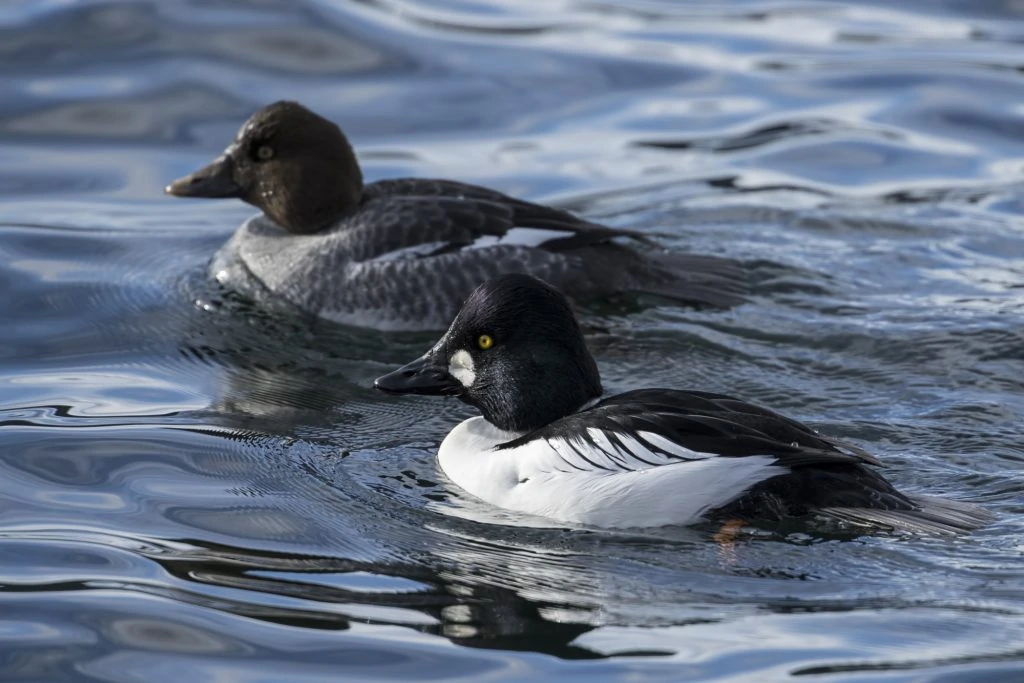
Barrow’s Goldeneyes are medium-sized ducks that are commonly mistaken for Common Goldeneyes because they have very similar features. Male Barrow’s Goldeneyes have black heads with a glossy purplish sheen. They have a white crescent-like patch behind their black bill.
They have golden yellow eyes and white chests and bellies. Their top half is black with distinct white shoulder bars.
Female Barrow’s Goldeneyes have gray bodies, a white collar around their necks, dark brown heads, yellow-orange bills, and the typical golden yellow eyes. They also have white wing patches like the males.
Juveniles are similar to females, except they have a faint white crescent mark of the adult males.
- Bucephala islandica
- Length: 16 – 20 in (41 – 51 cm)
- Weight: 38.4 oz (1088 g)
- Wingspan: 30 – 32 in (76 – 81 cm)
Barrow’s Goldeneye breed in western Canada, Alaska, and a few areas of eastern Canada near the coast before migrating to northwestern US states and the west coast of Canada.
You can find Barrow’s Goldeneyes in small mountain lakes and small ponds with nearby mature trees with nesting cavities. During migration, they stop at estuaries, bays, and inlets. In winter, you’ll find them along rocky ocean coasts or inland lakes.
During the breeding season, Barrow’s Goldeneyes favor aquatic insects and, in fact, will head to habitats that have no insect-eating fish around so they won’t have any competition for this type of prey. In winter, they will feast on crustaceans, mollusks, and small fish.
Barrow’s Goldeneye call:
Nests of Barrow’s Goldeneyes are usually in cavities in cliffs and trees, or they use old woodpecker holes. They may nest on the ground under a bush if there are no available cavities. The female lays six to twelve eggs and incubates them for about a month.
When they hatch, the female leads their young to where the food is so they can feed themselves. Sometimes, broods mix with other broods, particularly if the female leaves early or when broods are part of a territorial dispute among females.
Attracting Barrow’s Goldeneyes to your backyard is possible if you put up nest boxes for them before the breeding season.
Fun Fact: In Iceland, around Lake My’vatn, local residents always have nest boxes around their homes and barns for Barrow’s Goldeneyes. It has been a long-standing tradition for the people in this area to host these ducks.
12. King Eider
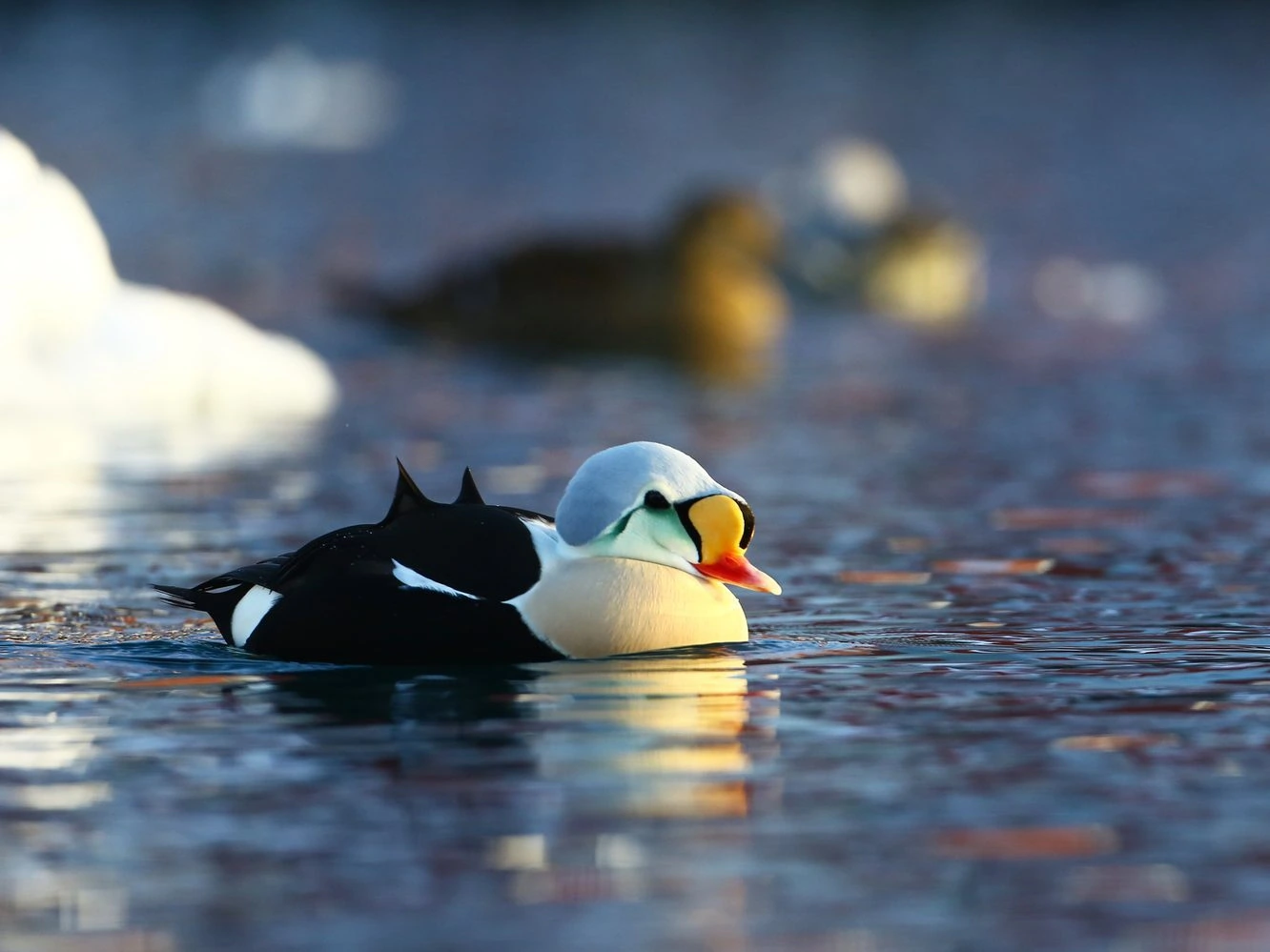
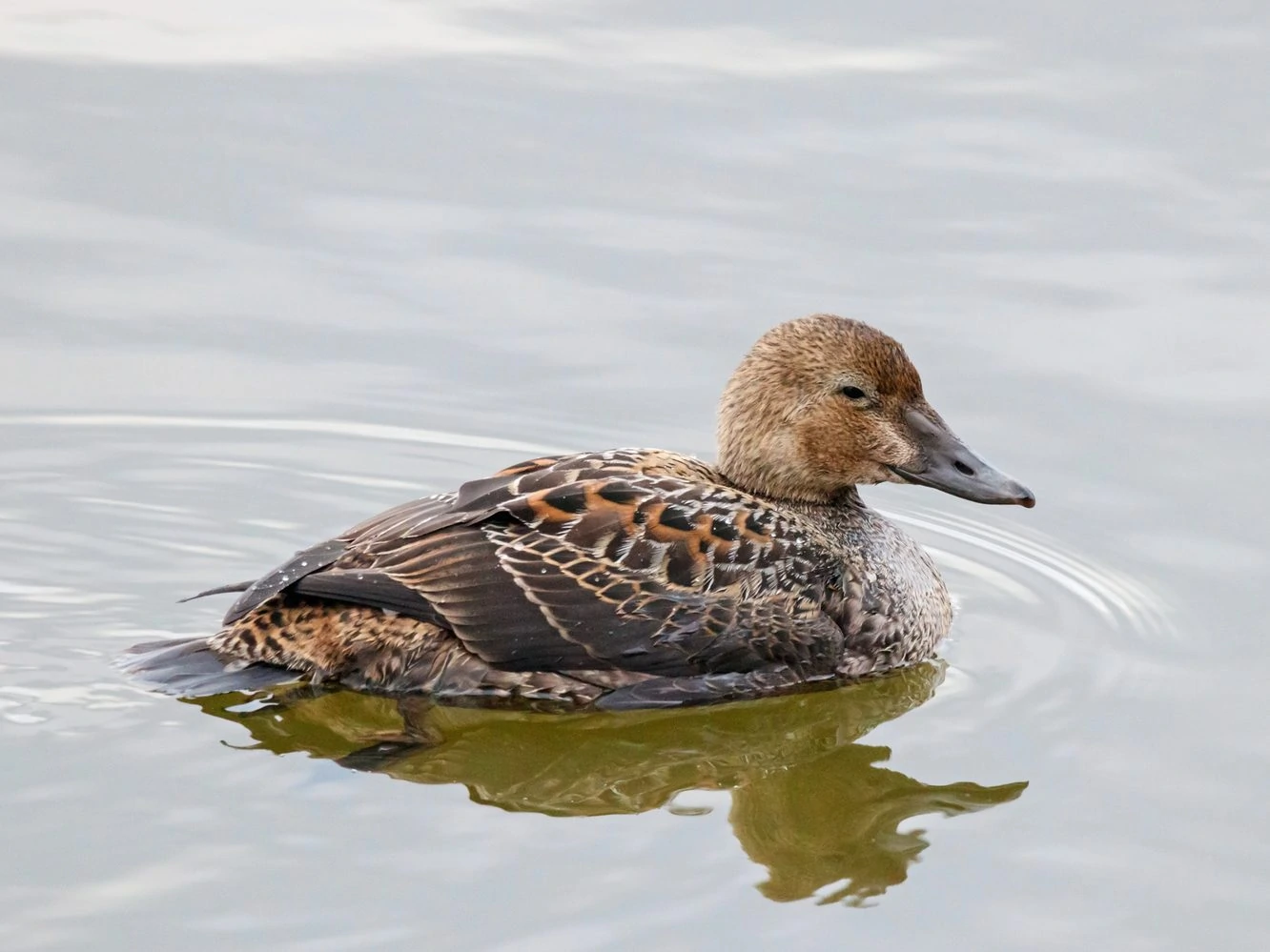
Male King Eiders are large ducks that are often easily identifiable because of their multi-colored heads and distinct orange knob with a black outline above their short red bills.
Their crown and nape are pale-blue, but their face is greenish. Their chests are white, and their wings, bellies, and back are black. They have white patches on their wings and on the base of the tail.
Female King Eiders, or Queen Eiders, as they’re commonly called, are brown in color all around. The feathers on her back and flanks have distinct, intricate chevron patterns, while the nape and chest have fine streaky lines. Her bill is black, and her cheek and neck are plain brown.
Juveniles are dark brown like the females but have a white chest and orange bill like the males.
- Somateria spectabilis
- Length: 18 – 25 in (46 – 64 cm)
- Weight: 59.2 oz (1678 g)
- Wingspan: 35 – 40 in (89 – 102 cm)
King Eiders breed in coastal northern Canada before migrating for winter to the south coast of Alaska and the east coast of Canada, and the coasts of northeastern US states.
You can find King Eiders, usually near water and in barren tundra habitats, and they prefer rocky coasts and the open seas. They will usually mix with other wintering birds in coastal waters and can form flocks exceeding 100,000 birds. During the breeding season, they are seen in and around freshwater lakes and ponds.
When in the open sea, King Eiders dive deeply, reaching the bottom to feed off on the organisms they find there. They may also pick off prey that are on the underside of sea ice. When in lakes and ponds, they usually stay on the surface of the water, straining the water for mollusks, crustaceans, aquatic insects, and algae.
King Eider call:
Male King eider
Female King Eider
Nests of King Eiders are built by the female on the ground near water. They are usually “scrape nests”, or hollowed-out ground lined with grass and feathers from the female herself. She lays two to seven eggs that she incubates for twenty-two to twenty-three days.
Fun Fact: Spring creates an awe-inspiring migration of hundreds of thousands of King Eiders to their arctic nesting grounds.
13. Tufted Duck
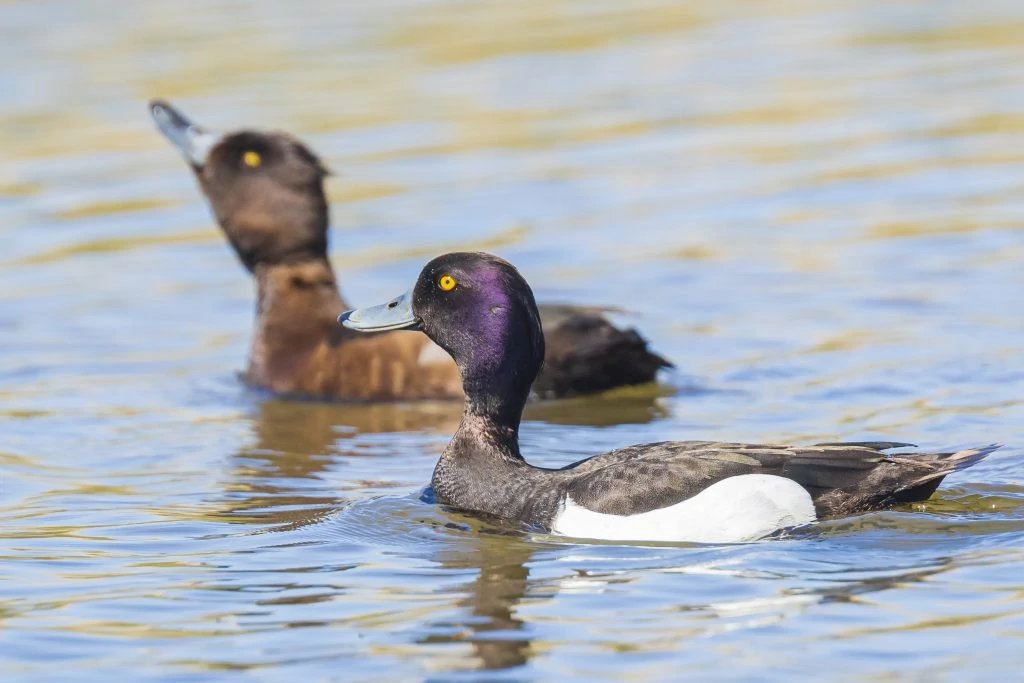
Tufted Ducks are small diving ducks with a long, thin crest behind its head. They have a blue-gray bill and brilliant yellow eyes that stand out against their black head.
Males’ upper half of their bodies are glossy black with a purple color, and the lower half is white. Their webbed feet are black as well.
Females have a shorter crest, dark brown on the breast and back, lighter brown on the sides, and white on their bellies. In flight, both their bodies have a white stripe on their wings.
- Aythya fuligula
- Length: 17 – 18 in (43 – 46 cm)
- Weight: 35.97 oz (1019 g)
- Wingspan: 30 – 35 in (76 -89 cm)
Tufted Ducks are usually found in Eurasia, but they wander to the coasts of the US and Canada, mainly in winter.
You can find Tufted Ducks in large lakes and bays, marshy wetlands, lakes, and ponds with dense vegetation. They’re also found on coastlines, shorelines, and sheltered ponds.
Tufted Ducks are agile divers reaching up to ten feet below the surface of the water. They feed on roots, seeds, and buds of plants and eat occasional animals like small fish, clams, snails, and insects.
Tufted Duck call:
Male Tufted Duck
Female Tufted Duck
Nests of Tufted Ducks are built on the ground, hidden behind tall grass, weeds, and other plant vegetation. They are made of grass and lined with feathers. The females lay as many as ten eggs, and they take twenty-eight days to hatch.
Fun Fact: Tufted Ducks have slowly begun to expand their reach because of the creation of artificial lakes that are suitable habitats for them.
14. Spectacled Eider
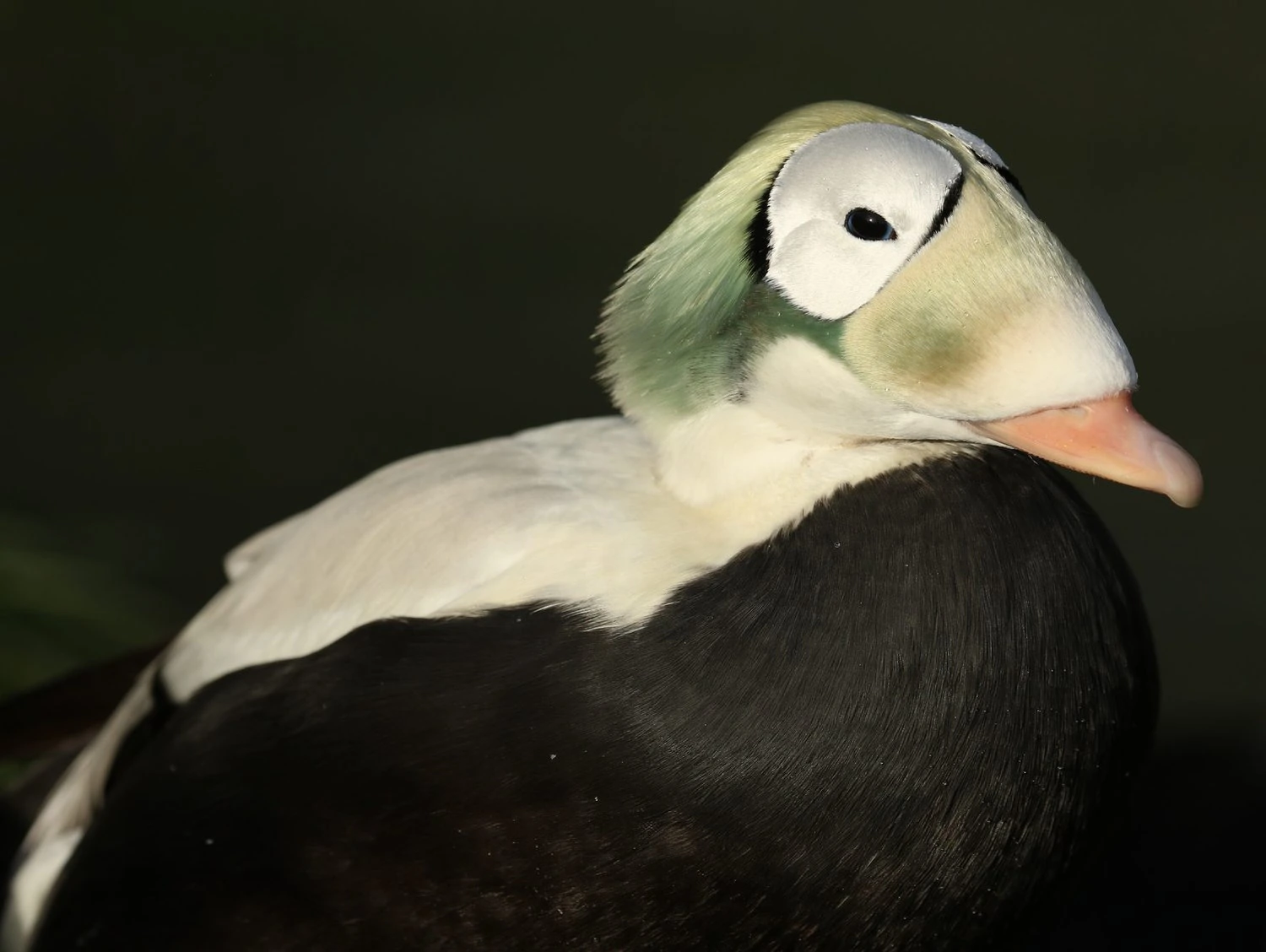
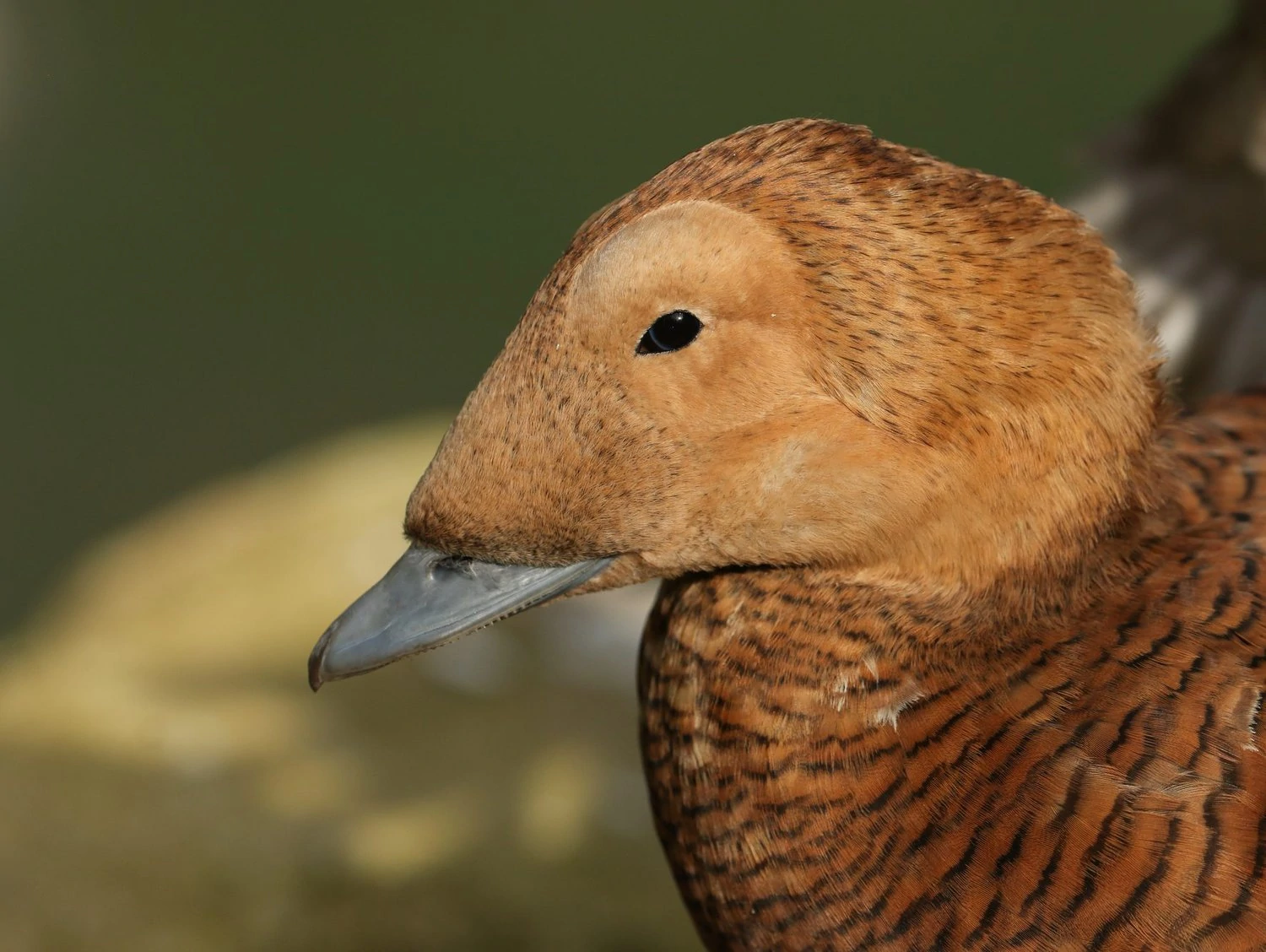
Spectacled Eiders are small ducks that are recognizable for their unique “spectacled” faces. Males have a more prominent “googles” feature on their white faces. The googles outline their eye area in black. They have greenish feathers at the back of their heads, and their bills are bright orange with white feathers extending up to the tip. Their upperparts are white, and their underparts are black.
Females and juveniles have light brown heads and brown bodies with even darker barrings everywhere. The “googles” or “spectacles” aren’t as prominent but are still slightly visible on the face. They also have dark bills.
- Somateria fischeri
- Length: 20 – 23 in (51 – 58 cm)
- Weight: 51.2 oz (1451 g)
- Wingspan: 35 – 36 in (89 – 91 cm)
Spectacled Eiders breed in Alaska and eastern Russia and winter in the Bering Sea.
You can find Spectacled Eiders along the open seas, coasts, and tundra (treeless plains in the Arctic) habitats. Their nesting sites are in small islands in lakes, particularly with grasses and marshes near the water’s edge. During the winter, they move to large breaks in the sea ice or polynyas.
In breeding grounds, Spectacled Eiders feast on a lot of insects, plants, and seeds. They will also dive to catch shrimp, snails, and clams. There are also plenty of mosses and sedges to eat. When they’re at sea, they feed on mollusk, clams, snails, and barnacles deep underwater.
Spectacled Eider calls:
Nests of Spectacled Eiders are usually found on small islands, pond shorelines, and hummocks (raised ridges). The female builds the nest with plant materials and her own downy feathers as lining. She will lay between three to six eggs which she solely incubates for about twenty-four days. When the eggs hatch, chicks are led to the water to find their own food.
Fun Fact: The Spectacled Eider molts at sea.
15. Common Pochard
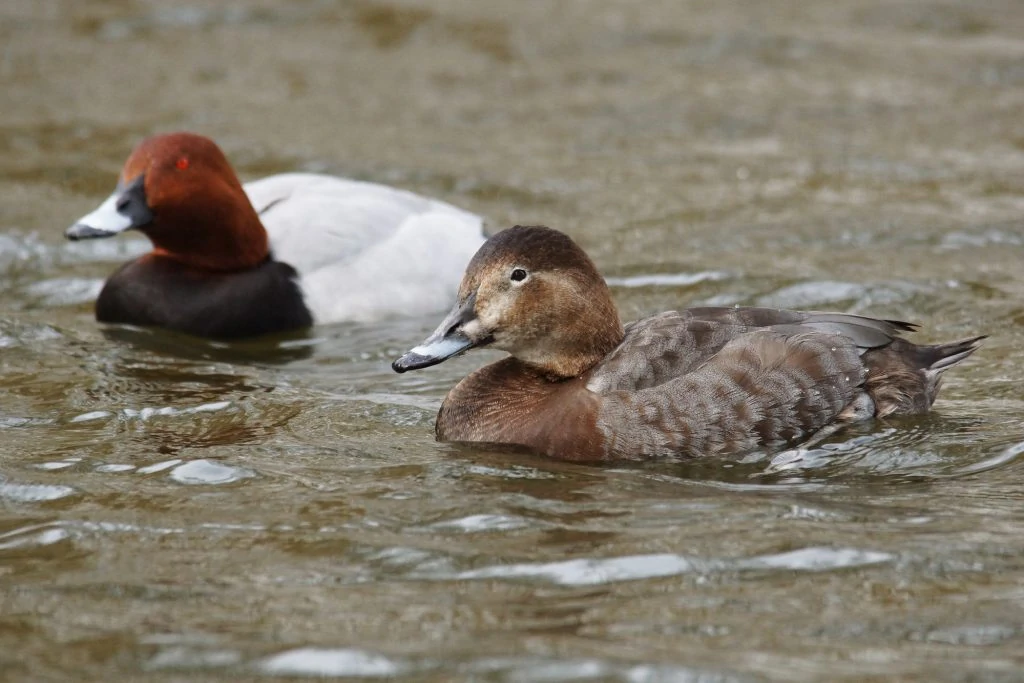
Common Pochards are medium-sized, elegant-looking birds. Males have bold, red heads and throats, long black bills with a gray band in the middle, black bellies, white backs and flanks, and black tails. They also have red eyes.
Females are less striking, but their pattern combinations are stunning. They are mostly brown and have a scalloped pattern, gray-brown colored backs, and flanks. They do share the same long, black bill with the gray band as the males.
- Aythya ferina
- Length: 16.5 – 23 in (42 – 58 cm)
- Weight: 28.8 oz (816 g)
- Wingspan: 29 – 35 in (74 – 89 cm)
Common Pochards are usually found in Eurasia and Africa, but they occasionally wander into Alaska.
You can find Common Pochards in different types of water habitats, like lakes, reservoirs and hardly-moving rivers, and marshes. They prefer areas with dense vegetation along the shoreline and a water depth that’s suitable for diving. They may also be occasionally found in brackish water areas, but they much prefer freshwater habitats.
Common Pochards dive and swim underwater for food. They may keep their head underwater while feeding on seeds, stems, leaves, and roots of aquatic plants. They may also eat algae and aquatic insects, mollusks, small fish, and crustaceans.
Common Pochard Call:
Male Common Pochard
Female Common Pochard
Nests of Common Pochards are shallow depressions concealed in thick vegetations on the ground, built out of grass stems and feathers and very close to water. The female lays six to twelve eggs that she incubates for twenty-five days.
Fun Fact: Male Common Pochards look very similar to Redheads. The difference lies in the color of their eyes. Male Common Pochards have red eyes while Redheads have yellow eyes.
16. Smew
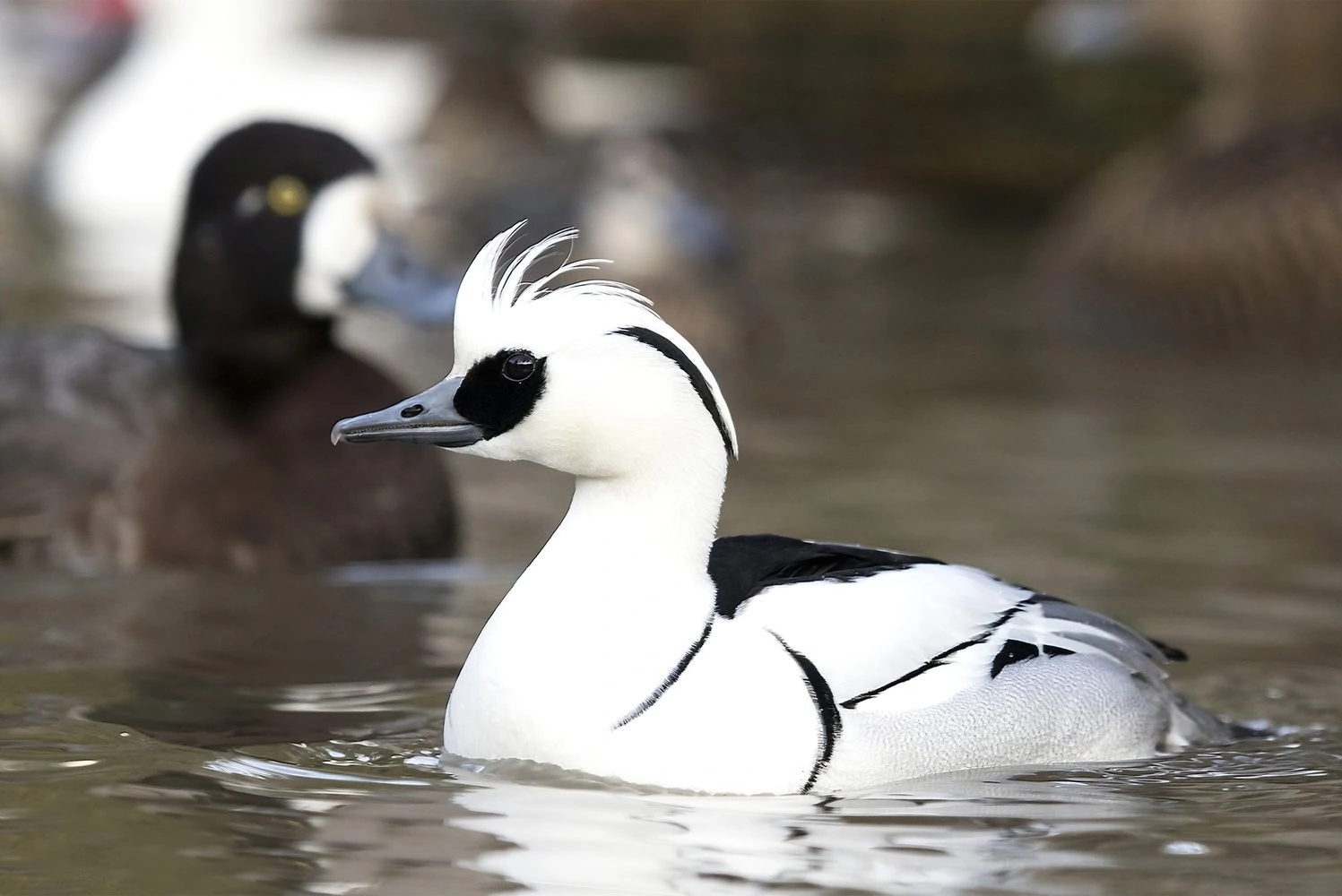
Smews are the only living members of the genus Mergellus. Male Smews are stunning since their feathers look like cracked ice. They are white overall, with a white crest and black patches and ‘veins.’
Female Smews look nothing like the males and may even be mistaken for ruddy ducks. They have reddish heads with a white patch at the base of their hooked and serrated bills, white throats, dark gray backs, and lighter gray breasts and bellies with a scaled pattern.
- Mergellus albellus
- Length: 14.5 – 17 in (37 – 43 cm)
- Weight: 22.4 oz (635 g)
- Wingspan: 24 – 26 in (61 – 66 cm)
Smews are usually found in Eurasia, but they wander into North America.
You can find Smews around fish-rich lakes and slow-moving rivers. During the breeding season, Smews will head to forests with pine trees that are near the same water regions.
Smews dive and pursue their prey underwater, such as insects and small fish.
Smew Call:
Nests of Smews are normally found in tree holes or tree cavities, such as old woodpecker nests. The female will simply line the interior with down and lay anywhere from six to nine eggs. She will incubate them for about a month.
Fun Fact: The term “smew” has been used since the 17th Century, but no one actually knows how it came to be. It was most likely derived from “smee,” a dialectal term for “wild duck.”
17. Common Shelduck
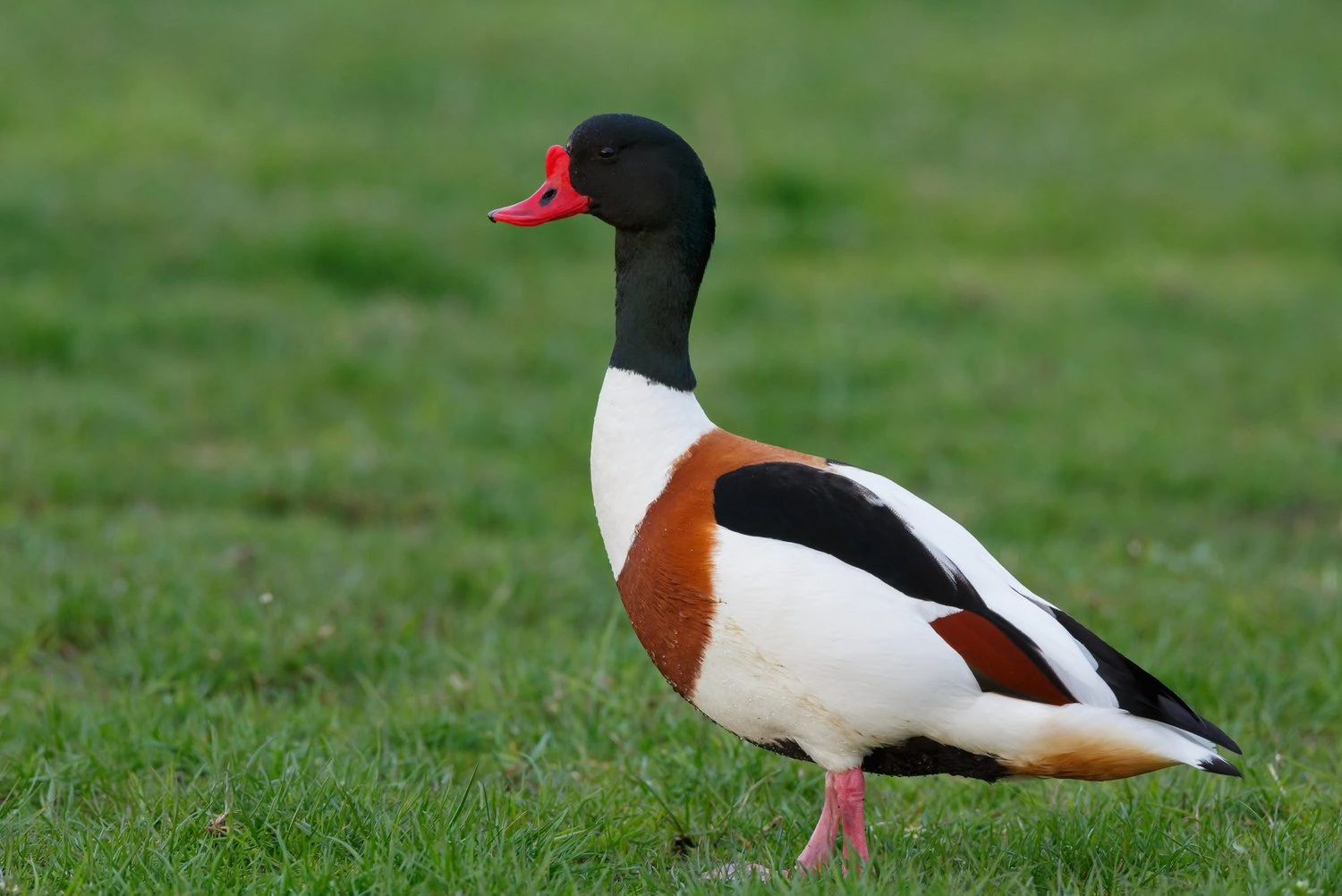
Male Common Shelducks are easy to spot. They have striking dark green (almost black) heads with bright, reddish-pink bills that have a large knob at the base. Their bodies are white with a reddish-brown band around their breasts and patches of black on their sides and bellies. Females have the same but duller coloring and pattern as the males.
- Tadorna tadorna
- Length: 25 in (63.5 cm)
- Weight: 35.2 oz (997 g)
- Wingspan: 39 in (100 cm)
Common Shelducks are usually found in Eurasia and North Africa, but they are sometimes spotted in North America.
You can find Common Shelducks in marshes and estuaries. They are also commonly found in coastal areas and inland waters like lakes and rivers.
Common Shelducks often feed on invertebrates, small shellfish, and aquatic snails. Mollusks, crustaceans, and insects are their staple food. They are known to feed at night.
Common Shelduck Call:
Nests of Common Shelducks are usually in enclosed spaces, like artificial structures, hollows of trees, haystacks, and gnarled roots. They are also known to use the burrows of animals like rabbits or badgers.
The female lays eight to ten eggs, but the nest may contain more when other females dump their own eggs in. The incubation period lasts a month, and when the young hatch, some of them join a “nursery” of other young and are taken care of by other adults in the flock.
Fun Fact: Common Shelducks sometimes stomp their feet on the sand or mud to rattle the snails buried under and bring them to the surface.

